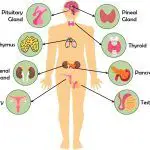The process of conversion of RNA (Ribonucleic acid) from the DNA (Deoxyribonucleic acid) template is known as Transcription. However, when the RNA (mRNA) template is converted into protein (amino acid sequence) it is known as translation. We can also say that transcription is the initial step of gene expression, which gives rise to the primary transcript in the form of mRNA … [Read more...] about Difference Between Transcription and Translation
Difference Between A, B and Z DNA Double Helix Structure
The A and B forms of DNA are right-handed double helical structure, while Z form of DNA is left-handed double helical structure. The DNA molecule exists in different forms under the different condition in a cell, these variations in the conformations can be due to the salt concentrations, hydration level, DNA sequence, the presence of metal ions, direction of supercoiling, … [Read more...] about Difference Between A, B and Z DNA Double Helix Structure
Difference Between Adaptation and Evolution
An example of the adaptation are some plants which have adapted their life in the deserts or the Grey whales who migrate thousands of miles every year from the cold Arctic Ocean to the coast of Mexico. However, an example of evolution is Darwin's Finches, which are the finches on the Galapagos Islands, where all have developed different beaks, originally these finched used to … [Read more...] about Difference Between Adaptation and Evolution
Difference Between Living and Non-Living Things
The things which have life are living things, while the things which do not have life are non-living things. But if we try to find out the matter in deep, we will notice many important aspects on which we can differentiate living and non-living things. The most important point is that living things can reproduce and can give birth to the young of their kind, which non-living … [Read more...] about Difference Between Living and Non-Living Things
Difference Between Endocrine and Exocrine Glands
Glands are the ingrowth of the top layer of the skin i.e. epithelium. This ingrowth can have a tubular, simple, branched or compound formation. They are the group of cells that release a chemical substance as per the demand of the body. We can divide them into two categories- Endocrine and Exocrine. These two play a critical role in controlling the body, its growth and … [Read more...] about Difference Between Endocrine and Exocrine Glands




